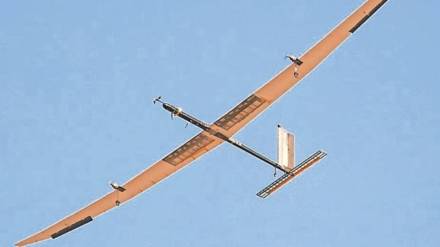GalaxEye, a space technology startup based in Bangalore, has made a groundbreaking achievement in aerospace innovation. The company successfully tested its Synthetic Aperture Radar (SAR) technology on a subscale High Altitude Pseudo-Satellite (HAPS) developed by the National Aerospace Laboratories (NAL). This marks the first time a private company has conducted SAR trials on a HAPS platform.
About HAPS
HAPS are high-flying drones that operate in the stratosphere. They can stay aloft for long periods, powered by solar energy and advanced batteries. Unlike traditional cameras, SAR can capture high-quality images regardless of weather conditions or time of day, overcoming challenges like cloud cover.
GalaxEye and NAL have formalized their collaboration through a Memorandum of Understanding (MoU). This partnership focuses on developing, integrating, and testing SAR payloads for HAPS. Both organizations are committed to advancing aerospace technology.
Suyash Singh, Co-founder and CEO of GalaxEye Space, expressed his excitement about the collaboration with NAL. He stated, “The rigorous test flights have provided invaluable insights, paving the way for further R&D endeavors. Our focus remains on optimizing SAR with low Size, Weight, and Power (SWaP) characteristics, unlocking unique phenomenology.”
An NAL spokesperson highlighted the importance of SAR technology for HAPS, noting that GalaxEye’s drone-based SAR capabilities show great promise. Although initial tests are promising, more tests are needed before the technology can be deployed for practical applications.
Singh emphasized the significance of this achievement for India’s technological prowess. He noted, “Historically, globally SAR technology for HAPS has been confined to a few governmental space agencies with limited operational implementation. GalaxEye’s breakthrough will position India at the forefront of SAR innovation, aligning seamlessly with the ‘Aatmanirbhar Bharat’ initiative. By bolstering national defense capabilities and fostering technological self-reliance, we aim to redefine global standards.”
SAR technology has many applications beyond defense. Singh explained that it holds immense potential for environmental monitoring and disaster management. The company’s vision is to use aerospace innovations to contribute to societal well-being.
Its pioneering efforts in radar imaging through Unmanned Aerial Vehicles (UAVs) are notable. In 2023, they achieved significant milestones in collaboration with organizations like ISRO and DRDO. This achievement underscores India’s growing aerospace landscape and heralds a new era of technological excellence. As India ascends as a global leader in aerospace innovation, the company stands out as a beacon of ingenuity, reshaping paradigms and driving transformative advancements.
The integration of high-tech functionalities with HAPS platforms holds great promise for enhancing national security and intelligence gathering, ushering in a future defined by innovation and resilience.
